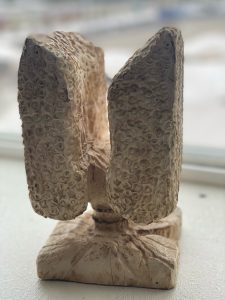 I chose to carve a representation of ARDS. I inverted the “bronchial tree” to play upon the name. The trunk has tracheal rings like trees have rings. I am a sucker for word play:) I tried to illustrate the stiffness of the lung through the squared off shape of the lung. I lightly torched the outside of the lung to suggest lung damage to the alveoli. I carved the piece out of a block of beetle kill white spruce and tried to make the tree foliage look like a cross between alveoli and the beetle tracks left under the bark post infestation.
I chose to carve a representation of ARDS. I inverted the “bronchial tree” to play upon the name. The trunk has tracheal rings like trees have rings. I am a sucker for word play:) I tried to illustrate the stiffness of the lung through the squared off shape of the lung. I lightly torched the outside of the lung to suggest lung damage to the alveoli. I carved the piece out of a block of beetle kill white spruce and tried to make the tree foliage look like a cross between alveoli and the beetle tracks left under the bark post infestation.

Chris’s STEAM project shows the effects of acute respiratory distress syndrome (ARDS), which is trauma to the lungs caused by pathologies such as pneumonia, COVID-19, or inhalation of toxic chemicals. ARDS damages the capillary endothelial and epithelial cells and permeates them. Fluid from the capillaries leak into the alveoli, which leads to the surfactant that helps keep the alveoli open to leak into the capillaries as well. These leaks create a protein-rich environment and cause inflammation, apoptosis, necrosis, and possibly a pulmonary shunt as well. A person can heal from ARDs, but it can leave damage such as fibrotic scarring. It also has a high mortality rate. Chris shaped wood to depict lungs and the effect ARDs has on them. Without the surfactant to keep the alveoli open, the lung becomes stiff, which Chris illustrates by squaring off the lungs. He also torched the wood’s foliage, which represents the alveoli. The lung damage triggers the release of pro-inflammatory cytokines. Neutrophils are sent to the lung tissue where it releases toxic mediators. Additionally, Chris used wood that was killed by bark beetles because of the pattern they leave under the bark when they infest trees. Chris made the lungs out of bark because he wanted them to quite literally represent a “bronchial tree.” His method of and the way he shaped the wood to represent the effect of ARDs is very important to his STEAM project.